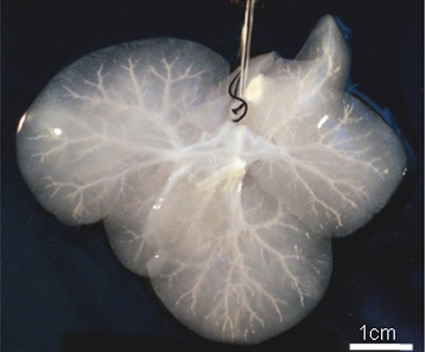Derren Brown's Blog, page 65
November 4, 2010
Snake gives 'virgin birth' to extraordinary babies

"A female boa constrictor snake has given birth to two litters of extraordinary offspring. Evidence suggests the mother snake has had multiple virgin births, producing 22 baby snakes that have no father. More than that, the genetic make-up of the baby snakes is unlike any previously recorded among vertebrates, the group which includes almost all animals with a backbone. Details are published in the Royal Society journal Biology Letters.
Virgin births do occur among animals. Many invertebrates, such as insects, can produce offspring asexually, without ever having mated. They usually do this by cloning themselves, producing genetically identical offspring. But among vertebrate animals, it remains a novelty, having been documented among less than 0.1% of vertebrate species. In 2006, scientists discovered that two komodo dragons (Varanus komodoensis), the world's largest lizard species, had produced eggs that developed without being fertilised by sperm – a process called parthenogenesis. Then in 2007, other scientists found that captive female hammerhead sharks (Sphyrna tiburo) could also reproduce without having sex. But vertebrates generally reproduce sexually. Not including genetic material from the father – essentially having just a single biological parent – reduces genetic diversity and makes it more difficult for organisms to adapt to, for example, changed environmental conditions or the emergence of a new disease.
Now, a team of scientists and snake experts based in the US has identified the first case of a boa snake having a virgin birth. "Although parthenogenesis has been documented in a few snake species, our findings are truly novel for a number of reasons," says Dr Warren Booth of North Carolina State University in Raleigh, US. He led the team that made the latest discovery, and also worked with the researchers who documented a virgin birth in a hammerhead shark. "The female [boa] has had not one virgin birth, but actually two, in spite of being housed with and observed to be courted by multiple males. "All offspring are female. The offspring share only half the mother's genetic make-up," he told the BBC. What is more, the female snake in question has produced offspring the like of which have never been seen before.
In the two years following 2007, the captive-born female Boa constrictor produced two litters of live offspring, at the same time as being housed with four male snakes. First impressions suggested there was something special about these babies: all were female and all had a particular, rare caramel colouration. This colour is a rare recessive genetic trait, which is carried by the mother but not by any of the potential fathers. So Dr Booth and colleagues conducted a series of genetic tests on the snakes to solve the enigma. What they found was astonishing. DNA fingerprinting revealed that the offspring had a number of genetic differences from any of their potential fathers, which ruled out all the males as sires of the litter. That confirmed the first instance of a known virgin birth among boa snakes.
All the offspring also had very unusual sex chromosomes. Sex chromosomes are packages of DNA that drive the development of sexual characteristics; they essentially make animals genetically male or genetically female. Humans for example have X or Y sex chromosomes; females have two X chromosomes and males have a combination of an X and a Y chromosome. In place of X and Y, snakes and many other reptiles have Z and W chromosomes. In all snakes, ZZ produces males and ZW produces females. Bizarrely, all the snakes in these litters were WW."
Read more at BBC News (Thanks @powerofstrange)
Anger Makes People Want Things More
"Anger is an interesting emotion for psychologists. On the one hand, it's negative, but then it also has some of the features of positive emotions. For a new study published in Psychological Science, a journal of the Association for Psychological Science, researchers find that associating an object with anger actually makes people want the object—a kind of motivation that's normally associated with positive emotions.
People usually think of anger as a negative emotion. You're not supposed to get angry. But anger also has some positive features. For example, it activates an area on the left side of the brain that is associated with many positive emotions. And, like positive emotions, it can motivate people to go after something. "People are motivated to do something or obtain a certain object in the world because it's rewarding for them. Usually this means that the object is positive and makes you happy," says Henk Aarts of Utrecht University in the Netherlands, first author of the new study. He and his colleagues wanted to examine whether this also applies to the link between anger as a negative emotion and the desire to get your hands on something.
For the study, each participant watched a computer screen while images of common objects, like a mug or a pen, appeared on the screen. What they didn't realize was that immediately before each object appeared, the screen flashed either a neutral face, an angry face, or a fearful face. This subliminal image tied an emotion to each object. At the end of the experiment, the participants were asked how much they wanted each object. In a second version of the experiment, they had the person squeeze a handgrip to get the desired object—those who squeezed harder were more likely to win it. "
Read more at Psychological Science (Thanks Johnny5)
Scientists Discover New Way to Fight Common Cold Virus
"Cambridge, United Kingdom (AHN) – A research team led by Dr. Leo James from the Medical Research Council (MRC) Laboratory of Molecular Biology in Cambridge, have discovered that antibodies can battle viruses that cause the common cold, vomiting and gastroenteritis, by entering cells that house them.
Previously, it was believed that antibodies could only attack viruses outside cells or by blocking their entry into cells.
Once antibodies enter cells they quickly trigger a response, led by a protein called TRIM21 that pulls the virus into a disposal system used by the cell to get rid of unwanted material. Release of the TRIM21 protein is so quick that the virus is not given a chance to harm the cell.
It was also found that increasing the amount of TRIM21 protein in cells makes this process even more effective, suggesting new ways of making better antiviral drugs.
The research team however, stressed that it would take years of work and testing to find new therapies, and that their discovery would not work on all viruses."
Read more at Gantdaily (Thanks Johnny5)
November 3, 2010
The State of the Internet
"The infographic movie 'The State of the Internet' by creative agency Jess3 conveys exactly what is meant by its title, with a focus on highlighting a lot of numbers and statistics.
Still, it gives you plenty of food for thought…"
Via Sunday Mercury (Thanks @XxLadyClaireXx)
Scientist examines key to beauty
"Physical attractiveness might be determined by the way people move their faces and alter their voices instead of by the way they look, a researcher has said.
Dr Ed Morrison has been awarded a £94,000 grant to examine whether it is looks alone that makes someone's face attractive.
The evolutionary psychologist from the University of Portsmouth will look at whether it is determined by fixed aspects, such as symmetry of the face, or whether changing expressions and variation of voice can have an effect.
Dr Morrison, whose study is being funded by the Economic and Social Research Council (ESRC), said: "The old expression 'the camera never lies' might be proved wrong.
"There is a widespread assumption that photographs can capture the entirety of facial attractiveness but I want to challenge this belief by proving that facial movement and vocal variability are also important. There is already evidence to suggest that the same face might not be similarly attractive in a picture and a video.
"Attractiveness is important in areas such as romantic partnerships but also for non-romantic friendships, and in more surprising cases such as hiring, voting and jury decisions. Attractive people are often treated more favourably and are assumed to do better in life.
"Therefore understanding the basis of facial attractiveness judgements is crucial because it influences so many face-to-face interactions."
Dr Morrison predicted that his study will show people change their facial movement and alter their voice when they interact with a person they are attracted to. He explained that his research will allow him to quantify exactly how much attractiveness can be changed, and how much cannot."
Read more at Yahoo News (Thanks @XxLadyClaireXx)
Brain scans show more than buyers bargained for
"Putting on a convincing poker face might not depend on skill alone; it could also be down to the wiring of your brain.
Successful poker players and effective bargainers are good at bluffing: in other words, they can manipulate how other people see them. Until now the brain processes behind this ability have been poorly understood, but a new study has identified patterns of brain activity in talented bluffers.
"One of the most important things we do in life is to build models of other people in our minds that we can act upon," says Read Montague at the Baylor College of Medicine in Houston, Texas.
So why can some people put on a winning poker face while others can't help giving themselves away? To investigate, Montague scanned the brains of 76 volunteers while they acted as buyers in a bargaining game.
The aim of the game was to trick another player into selling a hypothetical item for less than its true value. In each round, the buyers were told the item's true value, and would suggest a price to the seller, but sellers would decide on the final selling price. The catch was that the sale would only count if the seller unwittingly agreed to a price lower than the real value. Neither buyer nor seller knew during the game whether a sale had counted or not.
The study revealed three types of buyer. Some honest participants just offered the true value, and others hid it, always suggesting a low price. But a third group – dubbed "strategists" – successfully bluffed to trick their opponents."
Read more at New Scientist (Thanks @XxLadyClaireXx)
November 2, 2010
Miniature Human Liver Grown in Lab; Seems to Work Like the Real Thing

"Researchers have built miniature human livers in the lab, which could lead to better drug discovery and could even point the way toward implantable artificial organs. The mini-livers seem to act like human livers in the lab, but it remains to be seen how well they'll survive and perform when transplanted into animals or, maybe one day, humans.
"We are excited about the possibilities this research represents, but must stress that we're at an early stage and many technical hurdles must be overcome before it could benefit patients," said Shay Soker, Ph.D., professor of regenerative medicine and project director. "Not only must we learn how to grow billions of liver cells at one time in order to engineer livers large enough for patients, but we must determine whether these organs are safe to use in patients.".
The researchers at Wake Forest's Institute for Regenerative Medicine created livers that weigh about 0.2 ounces each. That's not nearly large enough to keep a human alive (it would need to be about 80 times larger for that), but getting the organ made was a feat in itself. The livers were made using the extracellular scaffolding from an animal liver, after all of the animal's cells had been gently removed from it."
Read more at Discover
Taiwanese Woman Marries Self

"On November 6, Chen will be marrying herself at a special ceremony estimated to cost over NT$50,000 (or $5,675). Ever since opting for this unconventional act, she has received a bevy of attention in the spotlight—not to mention thousands of letters of support from women in similar predicaments.
The problem in Taiwan is that many women are marrying later and later, if at all. This has the government and older generations worried about a possible drop in births and the associated consequences. So in turn parents are constantly pestering their daughters to get married and bear children.
Chen hopes to change this annoying behavior by doing something so revolutionary and crazy that it'll make parents in Taiwan think twice.
"My work and experience are in good shape, but I haven't found a partner, so what can I do?" Chen asked. "It's not that I'm anti-marriage. I just hope that I can express a different idea within a bounds of a tradition."
And to top it all off, Chen intends on going on a honeymoon with herself to Australia immediately after the wedding."
Read more at Weird Asia News
How to Plug in a Brain
"For tens of thousands of people suffering from paralysis or neurodegenerative disease, a direct connection to a computer could soon restore speech and even mobility. Neurologist Leigh Hochberg of the VA Medical Center in Providence, Rhode Island, is leading the second clinical trial of a brain-computer link called BrainGate. The system uses a sensor implanted into the motor cortex. Previous studies have shown that BrainGate can allow paralyzed people to perform simple tasks such as moving a computer cursor. The current trial will evaluate its safety outside the lab. Two people are already testing BrainGate at home, using the device to manipulate objects on a computer, and Hochberg hopes to recruit 13 more participants.
Although implants can be placed right next to the relevant neurons in the brain, they have drawbacks. Implants can inflame the surrounding tissue, and scarring can disrupt the connection between neurons and electrodes. A sensor developed by University of Pennsylvania neurologist Brian Litt could address those problems. It consists of electrodes embedded in a flexible plastic mesh that molds to the brain's surface (but it does not penetrate the gray matter). Litt and his colleagues were able to record neural signals from cats' brains for a few weeks without causing inflammation. Neuroscientist Gerwin Schalk of the New York State Department of Health has found that test sensors placed on the outside of human brains pick up signals that can identify spoken or imagined words. "The surface is a sweet spot," he says."
Read more at Discover (Thanks @XxLadyClaireXx)
November 1, 2010
The robot that reads your mind to train itself
"Rajesh Rao is a man who believes that the best type of robotic helper is one who can read your mind.
In fact, he's more than just an advocate of mind-controlled robots; he believes in training them through the power of thought alone.
His team at the Neural Systems Laboratory, University of Washington, hopes to take brain-computer interface (BCI) technology to the next level by attempting to teach robots new skills directly via brain signals.
Robotic surrogates that offer paralyzed people the freedom to explore their environment, manipulate objects or simply fetch things has been the holy grail of BCI research for a long time.
Dr Rao's team began by programming a humanoid robot with simple behaviours which users could then select with a wearable electroencephalogram (EEG) cap that picked up their brain activity.
The brain generates what is known as a P300, or P3, signal involuntarily, each time it recognizes an object. This signal is caused by millions of neurons firing together in a synchronised fashion.
This has been used by many researchers worldwide to create BCI-based applications that allow users to spell a word, identify images, select buttons in a virtual environment and more recently, even play in an orchestra or send a Twitter message."
Read more at BBC News (Thanks Gareth E)
Derren Brown's Blog
- Derren Brown's profile
- 797 followers



